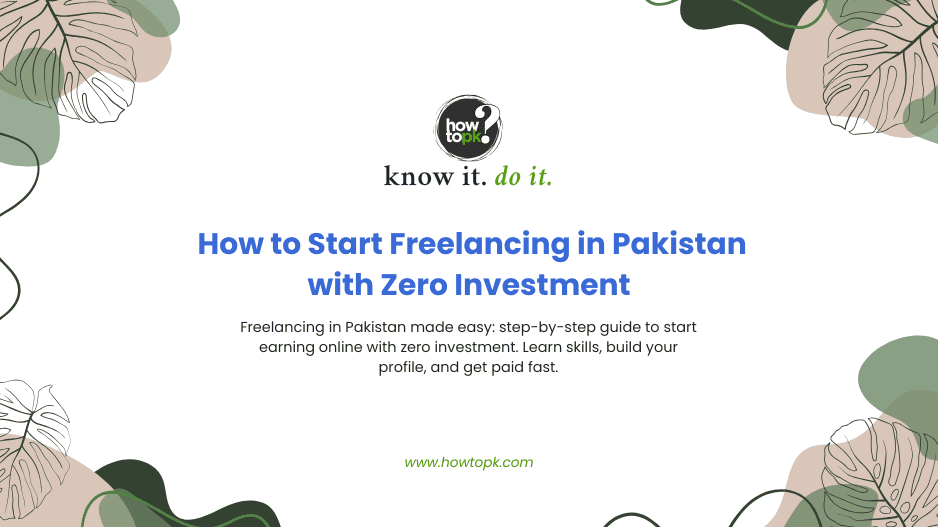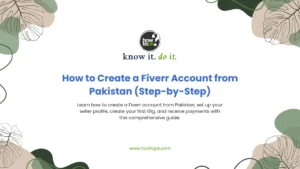Freelancing in Pakistan is more accessible than ever, but true success comes from understanding every step in detail. This guide is designed to walk you through the entire process, breaking down each stage with practical advice, real-world insights, and clear explanations. Whether you’re a complete beginner or someone looking to refine your approach, you’ll find everything you need right here.
Understanding Freelancing in Pakistan and Its Potential
Freelancing is a way of working where you offer your skills and services to clients on a project-by-project basis, rather than being tied to a single employer. In Pakistan, freelancing has become a popular path for people seeking flexibility, independence, and the chance to earn in foreign currencies. The global demand for digital services means that anyone with the right skills and determination can find opportunities, regardless of their background or location.
Freelancing allows you to set your own hours, choose the projects you want, and work from anywhere with a reliable internet connection. It’s especially appealing in Pakistan, where traditional job markets can be competitive and limited. Many people use freelancing to supplement their income, while others build full-time careers. The key is to approach freelancing as a serious business, even if you’re starting with no investment.
Step 1: Identify Your Skills and Interests
Before you can start freelancing, you need to know what you can offer. This step is about honest self-reflection and research.
Begin by listing out everything you’re good at, even if it doesn’t seem directly related to online work. Think about your education, hobbies, volunteer work, and any informal experience you have. For example, if you’ve helped friends with social media, written essays, or designed posters for school events, these are all valuable skills.
Next, research which skills are in demand on freelancing platforms. Writing, graphic design, web development, digital marketing, video editing, and virtual assistance are always popular, but there are also niches like data entry, translation, and customer support. If you’re unsure, browse job listings on platforms like Upwork or Fiverr to see what clients are looking for.
If you feel you lack marketable skills, don’t be discouraged. There are countless free resources online—YouTube tutorials, free courses on Coursera, and local initiatives like DigiSkills—that can help you learn the basics of almost any digital skill. Dedicate some time each day to learning and practicing, and remember that you don’t need to be an expert to get started. Many clients are happy to work with beginners if you show enthusiasm and a willingness to learn.
Step 2: Choose the Right Freelancing Platform
Selecting the right platform is crucial because it determines the type of clients you’ll attract and the kind of work you’ll do. Each platform has its own strengths and quirks.
Upwork is known for its wide range of job categories and a robust system for connecting freelancers with clients. You’ll need to create a detailed profile and submit proposals for jobs that interest you. Upwork uses a “Connects” system, which are tokens you use to apply for jobs. New users get a limited number for free each month, so use them wisely by targeting jobs that closely match your skills.
Fiverr operates differently. Instead of bidding on jobs, you create “gigs”—predefined services you offer at set prices. Clients browse these gigs and contact you if they’re interested. Fiverr is especially good for creative work, but you can offer almost any service.
Freelancer and PeoplePerHour are similar to Upwork, with a mix of project-based and hourly work. These platforms can be more competitive, but they also offer unique opportunities, especially for specialized skills.
When choosing a platform, consider your skill set, the type of work you want, and the payment methods available. It’s often best to start with one or two platforms to avoid spreading yourself too thin. Take time to explore each platform’s rules, fee structures, and best practices for new freelancers.
Step 3: Create a Strong, Professional Profile
Your profile is your digital first impression. It’s what clients see before deciding whether to contact you or consider your proposal.
Start with a clear, professional photo. You don’t need a studio portrait—a well-lit, friendly headshot taken with your phone will do. Dress neatly and smile to convey approachability.
Write a bio that highlights your skills, experience, and what makes you unique. Focus on how you can help clients solve their problems. For example, instead of saying “I am a writer,” try “I help businesses engage their audience with clear, compelling blog posts and articles.” If you’re new, mention your eagerness to learn and your commitment to delivering quality work.
List all relevant skills in the platform’s skills section. Be honest about your proficiency—overstating your abilities can lead to problems later. If you have certifications or have completed relevant courses, include them.
A portfolio is essential, even if you’re just starting. If you don’t have client work to show, create sample projects. For writers, this could be blog posts or articles on topics you know well. Designers can create logos, social media graphics, or website mockups. Developers can build simple websites or apps. The goal is to demonstrate your abilities and style.
Step 4: Build a Simple Portfolio
A portfolio is your proof of skill. It reassures clients that you can deliver what you promise, even if you haven’t worked with paying clients yet.
Start by creating a few sample projects tailored to the type of work you want. If you’re a writer, write articles or blog posts on topics you’re passionate about. If you’re a designer, create logos, banners, or social media posts for imaginary brands. Developers can build demo websites or apps and share screenshots or links.
You can host your portfolio for free using platforms like Behance (for design), GitHub (for code), or even Google Drive (for documents and images). If you want to go a step further, create a simple website using free tools like WordPress.com or Wix. This isn’t mandatory, but it can help you stand out.
If you have friends, family, or local businesses who need help, offer your services for free or at a low rate in exchange for permission to showcase the work in your portfolio. Always ask for testimonials—these are powerful trust signals for future clients.
Remember, your portfolio doesn’t need to be extensive. Three to five strong samples are enough to start. Update it regularly as you complete more projects.
Step 5: Start Bidding on Projects or Creating Gigs
With your profile and portfolio ready, it’s time to find work. This is where persistence and strategy matter most.
On platforms like Upwork and Freelancer, search for projects that match your skills and interests. Read each job description carefully and tailor your proposal to the client’s needs. Avoid generic copy-paste proposals. Instead, address the client by name if possible, mention specific details from their job post, and explain how you can help. Keep your proposals concise but informative.
On Fiverr, focus on creating clear, attractive gigs. Use high-quality images, write detailed descriptions, and set competitive prices. Think about what makes your service unique—do you offer faster delivery, extra revisions, or a special style? Highlight these in your gig.
Be prepared for rejection or silence, especially at the beginning. It’s normal to send dozens of proposals before landing your first job. Use each experience to refine your approach. If you get feedback, take it seriously and improve your profile or proposals accordingly.
Step 6: Network and Market Yourself
Freelancing isn’t just about waiting for clients to find you. Proactive networking can open doors to new opportunities and help you build a reputation.
Start by updating your LinkedIn profile to reflect your freelancing services. Connect with people in your industry, join relevant groups, and share your work or insights. Facebook and Instagram can also be powerful tools for reaching potential clients, especially if you share before-and-after examples, client testimonials, or tips related to your field.
Join online communities and forums for freelancers, both in Pakistan and globally. These spaces are great for learning, sharing experiences, and sometimes finding job leads. Don’t hesitate to ask questions or offer help to others.
Let your friends, family, and acquaintances know about your freelancing services. Word of mouth is powerful, especially in the early stages. You never know who might need your skills or can refer you to someone who does.
Step 7: Manage Your Time and Projects
Once you start getting work, staying organized becomes essential. Poor time management can lead to missed deadlines, unhappy clients, and lost income.
Set a realistic schedule based on your availability and commitments. Decide how many hours you can dedicate to freelancing each day or week, and stick to it as much as possible. Use free tools like Google Calendar to block out work sessions and set reminders for deadlines.
For managing tasks and projects, tools like Trello or Asana can help you break down large projects into smaller, manageable steps. Create checklists for each project and update them as you progress.
Communication is key. Always keep your clients updated on your progress, especially if you encounter delays or need clarification. Respond to messages promptly and professionally. If you’re working with clients in different time zones, clarify expectations about response times and availability.
Step 8: Handle Payments and Finances
Getting paid as a freelancer in Pakistan requires some planning, especially when dealing with international clients. Most major freelancing platforms handle payments for you, but it’s important to understand your options and the potential challenges.
International Platforms: Upwork, Fiverr, and Freelancer all offer secure payment systems. You can withdraw your earnings to your local bank account, JazzCash, or EasyPaisa. Payoneer is a popular choice for many Pakistani freelancers, as it allows you to receive payments from multiple platforms and transfer funds to your bank or mobile wallet. Wise (formerly TransferWise) is another option, known for good exchange rates and low fees.
Direct Clients: If you work with clients outside of freelancing platforms, you may need to use bank transfers (SWIFT/IBAN), Wise, Skrill, or other remittance services. Always provide accurate banking details and use the correct remittance codes to avoid delays or frozen funds. For local clients, JazzCash and EasyPaisa are convenient and widely used.
Record Keeping: Keep detailed records of your income and expenses. Use a simple spreadsheet or free accounting software. This will help you track your earnings, manage your budget, and prepare for tax season. In Pakistan, it’s important to declare your freelance income and understand your tax obligations to avoid legal issues.
Step 9: Overcome Common Challenges
Freelancing is rewarding, but it comes with its own set of challenges. Being prepared and proactive can help you navigate these hurdles.
Finding Consistent Work: It’s normal for new freelancers to struggle with finding regular projects. The key is persistence—keep applying, improve your skills, and ask for feedback. Over time, as you build a reputation and collect positive reviews, work will become more consistent.
Competition: The freelancing market is competitive, especially on popular platforms. Stand out by offering excellent service, being reliable, and continuously updating your portfolio. Specializing in a niche can also help you attract clients looking for specific expertise.
Internet and Payment Issues: Reliable internet is essential. If you face frequent outages, consider backup options like mobile data or working from co-working spaces. For payment issues, stick to recognized platforms and always use the correct remittance codes. If a payment is delayed or blocked, contact your bank or the platform’s support team immediately.
Time Management: Balancing multiple projects and deadlines can be overwhelming. Use project management tools, set clear priorities, and don’t take on more work than you can handle. Learn to say no when necessary to maintain quality and avoid burnout.
Step 10: Keep Learning and Growing
The most successful freelancers are those who never stop learning. The digital world evolves quickly, and staying updated is crucial.
Take advantage of free online courses on platforms like YouTube, Coursera, and DigiSkills. Focus on both technical skills (like writing, design, or coding) and soft skills (like communication, negotiation, and time management). Follow industry news and trends to keep your skills relevant.
After completing each project, ask your clients for feedback. Use their suggestions to improve your work and client experience. Don’t be afraid to experiment with new services or niches as you gain confidence.
Additional Tips for Success
- Start small: Don’t hesitate to take on small or low-paying jobs at first. These help you build your portfolio and gain valuable experience.
- Be professional: Always deliver work on time, communicate clearly, and treat freelancing as a real business.
- Stay persistent: Success rarely happens overnight. Keep learning, improving, and applying for new opportunities.
Common Issues and Solutions at Every Step
| Challenge & Context | Solution / Practical Tip |
|---|---|
| Identifying Skills & Interests – Unsure what’s marketable or lacking confidence | Research in-demand skills on freelancing sites; take free online courses; start with what you know and expand; remember clients value enthusiasm and willingness to learn. |
| Choosing the Right Platform – Too many options, unsure where to start | Pick 1–2 platforms aligned with your skills/goals; read reviews/guides; avoid spreading yourself thin by joining too many at once. |
| Creating a Professional Profile – Weak bio or no pro photo | Study top freelancer profiles; take a clear, well-lit headshot; write a client-focused bio; ask a friend to review your profile. |
| Building a Portfolio with No Experience – Nothing to showcase | Create sample projects; publish work on Medium, LinkedIn, Behance, Dribbble; offer low-cost/free work to friends/family/local businesses in exchange for portfolio rights and testimonials. |
| Bidding on Projects / Creating Gigs – No responses | Personalize each proposal to the client; avoid generic pitches; check clarity and professionalism; adjust gig description/images/pricing; analyze top performers in your niche. |
| Networking & Marketing – No clients outside platforms | Join relevant communities; share work on social media; let your network know you’re available; directly message potential clients with polite, tailored offers. |
| Managing Time & Projects – Missed deadlines or overwhelmed | Use Google Calendar, Trello, Asana; break work into smaller tasks; set realistic deadlines; communicate delays early; prioritize and learn to say no. |
| Handling Payments & Finances – Delays, fees, or banking confusion | Use Payoneer, Wise, or direct transfers; ensure accurate details & correct remittance codes; keep invoices & request FIRCs; contact support for delays; avoid informal payment channels. |
| Overcoming Competition – Struggling to stand out or find consistent work | Build a strong portfolio; gather positive reviews; specialize in a niche; keep skills current; be persistent in applying and marketing. |
| Continuous Learning – Feeling stuck as industry changes | Dedicate weekly time to learning; use free resources; seek feedback; stay curious and adaptable. |




